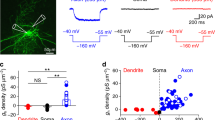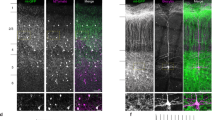Abstract
Action potentials are fundamental to relaying information from region to region in the nervous system. Changes in action potential firing patterns in neural circuits influence how the brain processes information. In our previous study, we focused on interneuron/perineuronal astrocyte pairs in the hippocampal CA1 region and reported that direct depolarization of perineuronal astrocytes modulated the firing pattern of interneurons. In the current study, we investigated the morphological and electrophysiological properties of perineuronal oligodendrocytes, and examined their modulatory effects on interneuronal firing in the CA1 region. Perineuronal oligodendrocytes only had a few processes, which were crooked, intricately twisted, and twined around the soma and proximal region of the main processes of adjacent interneurons. Whole-cell current patterns of perineuronal oligodendrocytes were homogenous and the current–voltage relationship showed remarkable outward rectification. Although the K+ channel blockers, tetraethylammonium and 4-aminopyridine, clearly blocked outward currents, Ba2+ did not significantly alter whole-cell currents. Unlike perineuronal astrocytes, the depolarization of perineuronal oligodendrocytes had no effect on interneuronal firing; however, when the interneurons were firing at a higher frequency, the hyperpolarization of perineuronal oligodendrocytes suppressed their action potentials. The suppressive effects of perineuronal oligodendrocytes were inhibited in the presence of a low concentration of tetraethylammonium, which selectively blocked deep and fast afterhyperpolarization. These results suggest that perineuronal oligodendrocytes suppress interneuronal firing through their influence on K+ channels, which are responsible for deep and fast afterhyperpolarization.








Similar content being viewed by others
References
Araque A, Parpura V, Sanzgiri RP, Haydon PG (1999) Tripartite synapses: glia, the unacknowledged partner. Trends Neurosci 22:208–215
de Hoz L, Simons M (2014) The emerging functions of oligodendrocytes in regulating neuronal network behavior. Bioessays 37:60–69
Berger T, Schnitzer J, Kettenmann H (1991) Developmental changes in the membrane current pattern K+ buffer capacity and morphology of glial cells in the corpus callosum slice. J Neurosci 11:3008–3024
Chvátal A, Anderová M, Ziak D, Syková E (1999) Glial depolarization evokes a larger potassium accumulation around oligodendrocytes than astrocytes in gray matter of rat spinal cord slices. J Neurosci Res 56:493–505
Yamazaki Y, Hozumi Y, Kaneko K, Sugihara T, Fujii S, Goto K, Kato H (2007) Modulatory effects of oligodendrocytes on the conduction velocity of action potentials along axons in the alveus of the rat hippocampal CA1 region. Neuron Glia Biol 3:325–334
Yamazaki Y, Hozumi Y, Kaneko K, Fujii S, Goto K, Kato H (2010) Oligodendrocytes: facilitating axonal conduction by more than myelination. Neuroscientist 16:11–18
Yamazaki Y, Fujiwara H, Kaneko K, Hozumi Y, Xu M, Ikenaka K, Fujii S, Tanaka KF (2014) Short- and long-term functional plasticity of white matter induced by oligodendrocyte depolarization in the hippocampus. Glia 62:1299–1312
Del Río Hortega P (1928) Tercera aportación al conocimiento morfológico e interpretación funcional de la oligodendroglía. Mem R Soc Esp Hist Nat 14:5–122
Vostrikov VM, Uranova NA, Orlovskaya DD (2007) Deficit of perineuronal oligodendrocytes in the prefrontal cortex in schizophrenia and mood disorders. Schizophr Res 94:273–280
Kim S, Webster MJ (2011) Integrative genome-wide association analysis of cytoarchitectural abnormalities in the prefrontal cortex of psychiatric disorders. Mol Psychiatry 16:452–461
Takasaki C, Yamasaki M, Uchigashima M, Konno K, Yanagawa Y, Watanabe M (2010) Cytochemical and cytological properties of perineuronal oligodendrocytes in the mouse cortex. Eur J Neurosci 32:1326–1336
Szuchet S, Nielsen JA, Lovas G, Domowicz MS, de Velasco JM, Maric D, Hudson LD (2011) The genetic signature of perineuronal oligodendrocytes reveals their unique phenotype. Eur J Neurosci 34:1906–1922
Battefeld A, Klooster J, Kole MH (2016) Myelinating satellite oligodendrocytes are integrated in a glial syncytium constraining neuronal high-frequency activity. Nat Commun. doi:https://doi.org/10.1038/ncomms11298
Yamazaki Y, Hozumi Y, Kaneko K, Li J, Fujii S, Miyakawa H, Kudo Y, Kato H (2005) Direct evidence for mutual interactions between perineuronal astrocytes and interneurons in the CA1 region of the rat hippocampus. Neuroscience 134:791–802
Williams S, Samulack DD, Beaulieu C, LaCaille JC (1994) Membrane properties and synaptic responses of interneurons located near the stratum lacunosum-moleculare/radiatum border of area CA1 in whole-cell recordings from rat hippocampal slices. J Neurophysiol 71:2217–2235
Buhl EH, Szilagyi T, Halasy K, Somogyi P (1996) Physiological properties of anatomically identified basket and bistratified cells in the CA1 area of the rat hippocampus in vitro. Hippocampus 6:294–305
Christie BR, Franks KM, Seamans JK, Saga K, Sejnowski TJ (2000) Synaptic plasticity in morphologically identified CA1 stratum radiatum interneurons and giant projection cells. Hippocampus 10:673–683
Rudy B, McBain CJ (2001) Kv3 channels: voltage-gated K+ channels designed for high-frequency repetitive firing. Trends Neurosci 24:517–526
Erisir A, Lau D, Rudy B, Leonard CS (1999) Function of specific K+ channels in sustained high-frequency firing of fast-spiking neocortical interneurons. J Neurophysiol 82:2476–2489
Barron KD, Marciano FF, Amundson R, Mankes R (1990) Perineuronal glial responses after axotomy of central and peripheral axons. A comparison. Brain Res 523:219–229
Ludwin SK (1979) The perineuronal satellite oligodendrocyte. A role in remyelination. Acta Neuropathol 47:49–53
Petito CK (1986) Transformation of postischemic perineuronal glial cells. I. Electron microscopic studies. J Cereb Blood Flow Metab 6:616–624
Torvik A, Soreide AJ (1975) The perineuronal glial reaction after axotomy. Brain Res 95:519–529
Kressin K, Kuprijanova E, Jabs R, Seifert G, Steinhäuser C (1995) Developmental regulation of Na+ and K+ conductances in glial cells of mouse hippocampal brain slices. Glia 15:173–187
McKhann GM II, D’Ambrosio R, Janigro D (1997) Heterogeneity of astrocyte resting membrane potentials and intercellular coupling revealed by whole-cell and gramicidin-perforated patch recordings from cultured neocortical and hippocampal slice astrocytes. J Neurosci 17:6850–6863
Tse FW, Fraser DD, Duffy S, MacVicar BA (1992) Voltage-activated K+ currents in acutely isolated hippocampal astrocytes. J Neurosci 12:1781–1788
Freund TF, Buzsáki G (1996) Interneurons of the hippocampus. Hippocampus 6:347–470
Tansey EP, Chow A, Rudy B, McBain CJ (2001) Developmental expression of potassium-channel subunit Kv3.2 within subpopulations of mouse hippocampal inhibitory interneurons. Hippocampus 12:137–148
Rudy B, Chow A, Lau D, Amarillo Y, Ozaita A, Saganich M, Moreno H, Nadal MS, Hernandez-Pineda R, Hernandez-Cruz A, Erisir A, Leonard C, Vega-Saenz de Miera E (1999) Contributions of Kv3 channels to neuronal excitability. Ann NY Acad Sci 868:304–343
Moreno H, Vega-Saenz de Miera E, Nadal MS, Amarillo Y, Rudy B (2001) Modulation of Kv3 potassium channels expressed in CHO cells by a nitric oxide-activated phosphatase. J Physiol 530:345–358
Matthews EA, Linardakis JM, Disterhoft JF (2009) The fast and slow afterhyperpolarizations are differentially modulated in hippocampal neurons by aging and learning. J Neurosci 29:4750–4755
Santini E, Quirk GJ, Porter JT (2008) Fear conditioning and extinction differentially modify the intrinsic excitability of infralimbic neurons. J Neurosci 28:4028–4036
Acknowledgements
This research was supported by JSPS KAKENHI [Grant-in-Aid for Scientific Research on Innovation Areas “Glial assembly: a new regulatory machinery of brain function and disorders” (Grant Number 25117005) and Grant-in-Aid for Scientific Research (C) (Grant Number 16K01943)].
Author information
Authors and Affiliations
Corresponding author
Ethics declarations
Conflict of interest
The authors declare that they have no conflict of interest.
Ethical Approval
All animal procedures were conducted in accordance with the National Institutes of Health Guide for the Care and Use of Laboratory Animals and were approved by the Committee for Animal Experimentation of Yamagata University.
Rights and permissions
About this article
Cite this article
Yamazaki, Y., Hozumi, Y., Kaneko, K. et al. Modulatory Effects of Perineuronal Oligodendrocytes on Neuronal Activity in the Rat Hippocampus. Neurochem Res 43, 27–40 (2018). https://doi.org/10.1007/s11064-017-2278-9
Received:
Revised:
Accepted:
Published:
Issue Date:
DOI: https://doi.org/10.1007/s11064-017-2278-9




